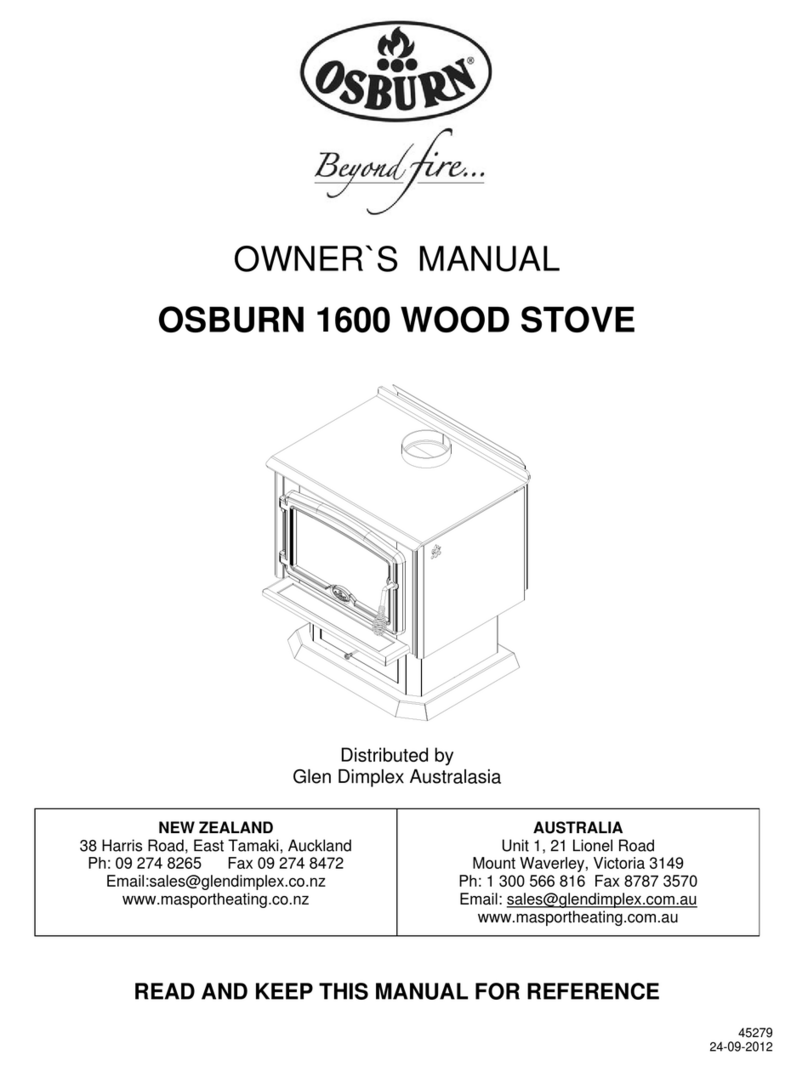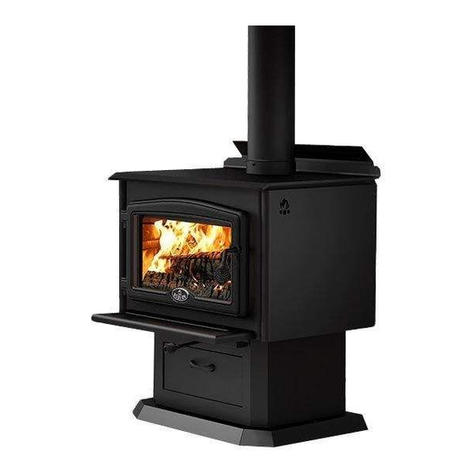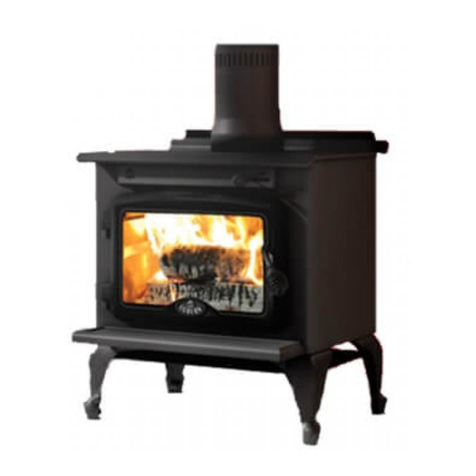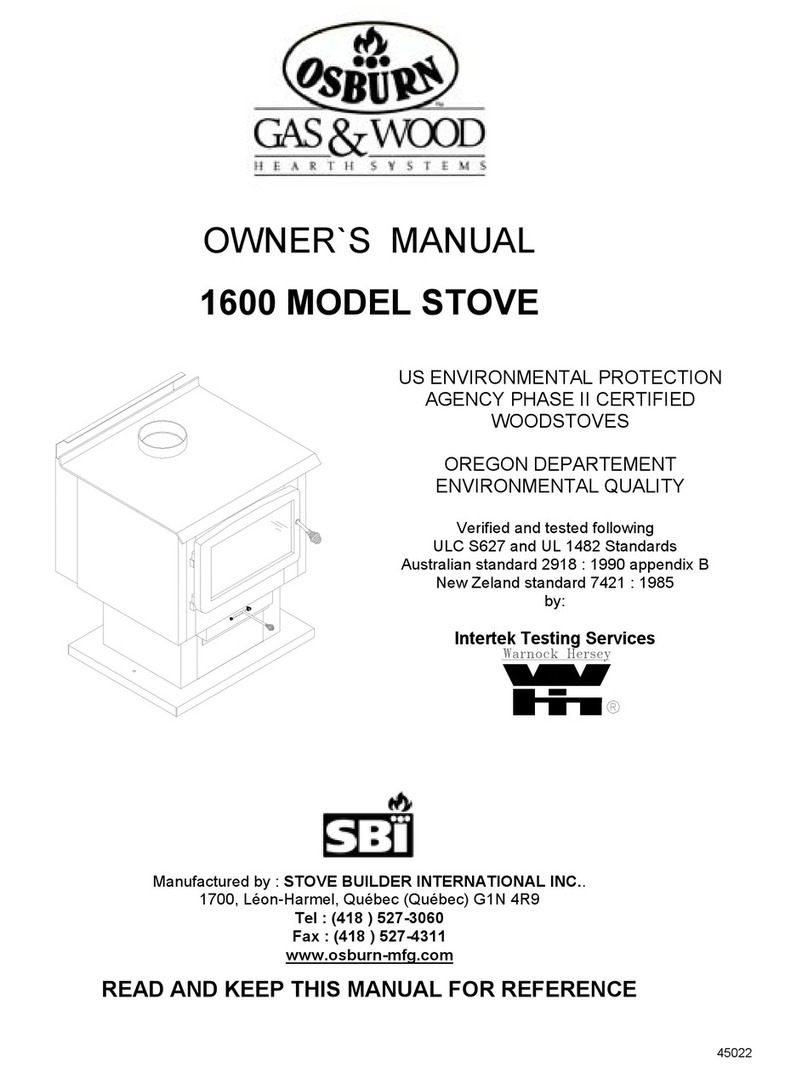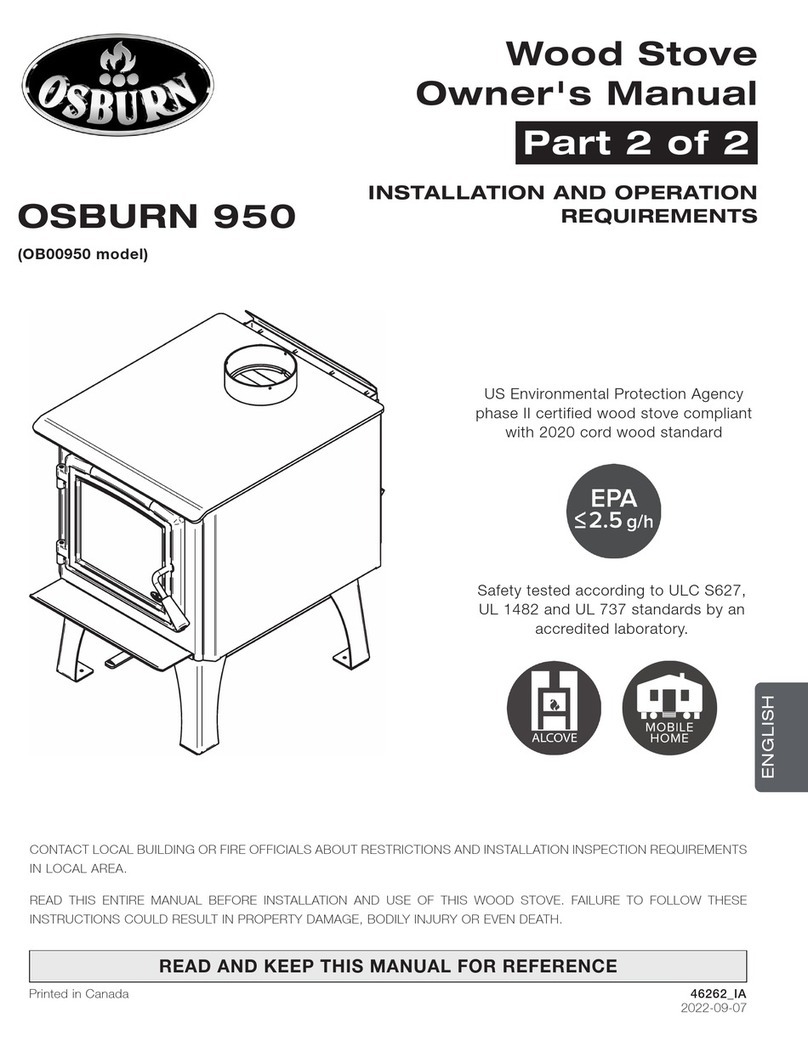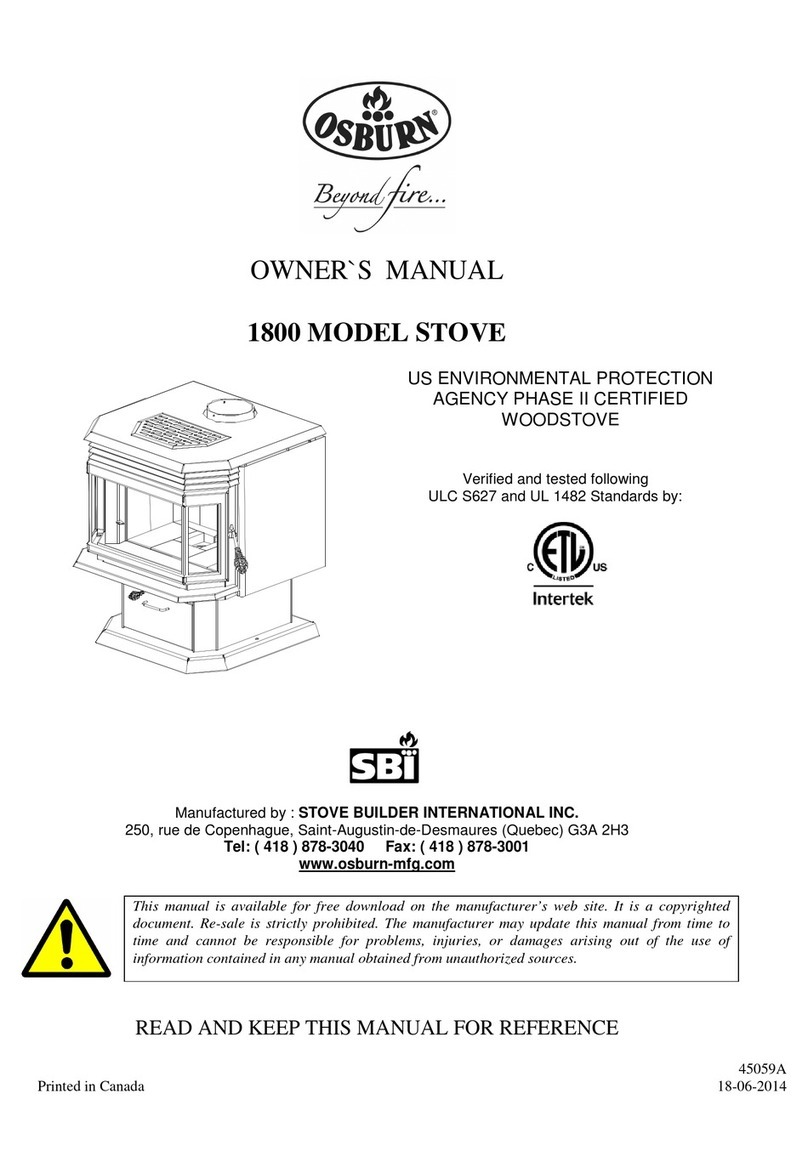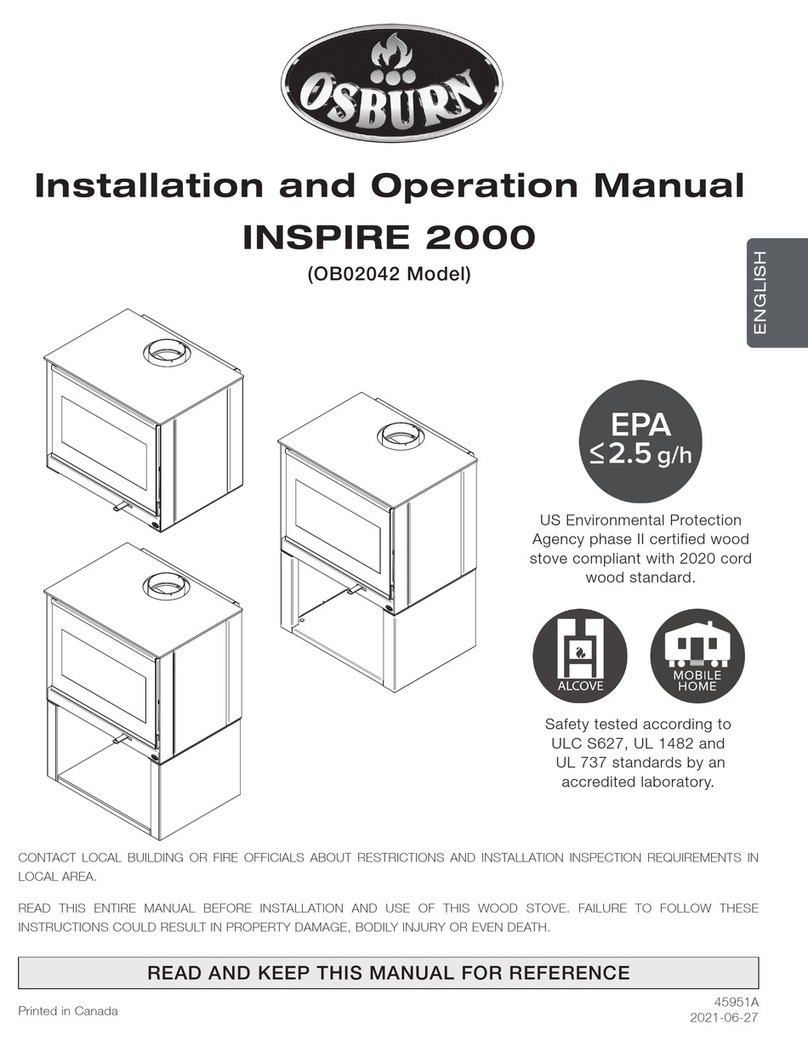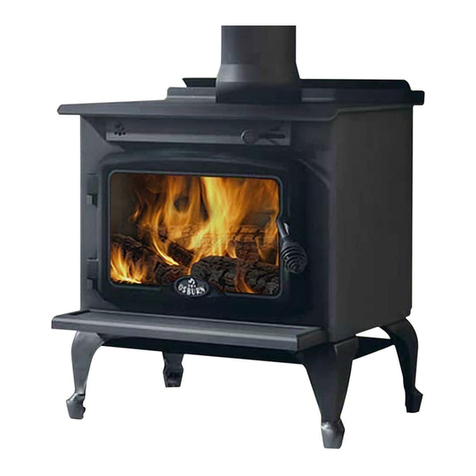Osburn 2200 User manual

READANDKEEPTHISMANUALFORREFERENCE
45055A
PrintedinCanada26‐09‐2014
INSTALLATIONANDOPERATIONMANUAL
2200
USENVIRONMENTALPROTECTION
AGENCYPHASEIICERTIFIEDWOOD
STOVE
SafetytestedaccordingtoULCS627
andUL1482Standards
byIntertekTestingServices
www.osburn‐mfg.com
StoveBuilderInternationalInc.
250,ruedeCopenhague,St‐Augustin‐de‐Desmaures(Quebec)CanadaG3A2H3
Tel:(418)878‐3040Fax:(418)878‐3001
Thismanualisavailableforfreedownloadonthemanufacturer’swebsite.Itisacopyrighted
document.Re‐saleisstrictlyprohibited.Themanufacturermayupdatethismanualfromtimeto
timeandcannotberesponsibleforproblems,injuries,ordamagesarisingoutoftheuseof
informationcontainedinanymanualobtainedfromunauthorizedsources.

2200InstallationandOperationManual
2_______________________________________________________________________________
THANKYOUFORCHOOSINGTHISOSBURNWOODSTOVE
AsoneofNorthAmerica’slargestandmostrespectedwoodstoveandfireplacemanufacturers,
StoveBuilderInternationaltakesprideinthequalityandperformanceofallitsproducts.Wewant
tohelpyougetmaximumsatisfactionasyouusethisproduct.
Inthepagesthatfollowyouwillfindgeneraladviceonwoodheating,detailedinstructionsforsafe
andeffectiveinstallation,andguidanceonhowtogetthebestperformancefromthisstoveasyou
buildandmaintainfires,andmaintainyourwoodheatingsystem.
Werecommendthatourwoodburninghearthproductsbeinstalledandservicedbyprofessionals
whoarecertifiedintheUnitedStatesbyNFI(NationalFireplaceInstitute®)orinCanadabyWETT
(WoodEnergyTechnologyTransfer)orinQuebecbyAPC(AssociationdesProfessionnelsdu
Chauffage).
Congratulationsonmakingawisepurchase.
Whenthisstoveisnotproperlyinstalled,ahousefiremayresult.Toreducetheriskoffire,
followtheinstallationinstructions.Contactlocalbuildingorfireofficialsaboutrestrictionsand
installationinspectionrequirementsinyourarea.
Pleasereadthisentiremanualbeforeyouinstallanduseyournewstove.Failuretofollow
instructionsmayresultinpropertydamage,bodilyinjury,orevendeath.Itisimportantthatyou
followtheinstallationsguidelinesexactly.
Youmayneedtoobtainabuildingpermitfortheinstallationofthisstoveandthechimneythat
itisconnectedto.Consultyourmunicipalbuildingdepartmentorfiredepartmentbefore
installationtodeterminetheneedtoobtainone.Werecommendthatyoualsoinformyour
homeinsurancecompanytofindoutiftheinstallationwillaffectyourpolicy.
REGISTERYOURWARRANTYONLINE
Toreceivefullwarrantycoverage,youwillneedtoshowevidenceof
thedateyoupurchasedyourstove.Keepyoursalesinvoice.Wealso
recommendthatyouregisteryourwarrantyonlineat:
www.osburn‐mfg.com/en/service‐support/warranty‐registration
Registeringyourwarrantyonlinewillhelpustoquicklytrackthe
informationweneedaboutyourstove.

2200InstallationandOperationManual
_______________________________________________________________________________3
Tableofcontent
PART A - OPERATION AND MAINTENANCE ...............................6
1Safety Information .....................................................................6
1.1SummaryofOperationandMaintenanceCautionsandWarnings......................................6
2General Information...................................................................7
2.1Osburn2200Specifications...................................................................................................7
2.2ZoneHeatingandHowtoMakeitWorkforYou..................................................................9
2.3TheBenefitsofLowEmissionsandHighEfficiency...............................................................9
2.4TheSBICommitmenttoYouandtheEnvironment............................................................10
2.4.1WhatisYourNewStoveMadeOf?..................................................................................10
3Fuel............................................................................................11
3.1MaterialsThatShouldNotbeBurned.................................................................................11
3.2HowtoPrepareorBuyGoodFirewood..............................................................................11
3.2.1WhatisGoodFirewood?.................................................................................................11
3.2.2TreeSpecies.....................................................................................................................11
3.2.3LogLength........................................................................................................................12
3.2.4PieceSize..........................................................................................................................12
3.2.5HowtoDryFirewood.......................................................................................................13
3.2.6JudgingFirewoodMoistureContent...............................................................................13
3.3ManufacturedLogs..............................................................................................................14
4Operating Your Stove..............................................................14
4.1YourFirstFires.....................................................................................................................14
4.2LightingFires........................................................................................................................15
4.2.1ConventionalFireStarting...............................................................................................15
4.2.2TheTopDownFire...........................................................................................................15
4.2.3TwoParallelLogs..............................................................................................................16
4.2.4UsingFireStarters............................................................................................................16
4.3MaintainingWoodFires......................................................................................................16
4.3.1GeneralAdvice.................................................................................................................16
4.3.2AshRemoval.....................................................................................................................17
4.3.3RakingCharcoal................................................................................................................17
4.3.4FiringEachNewLoadHot................................................................................................18

2200InstallationandOperationManual
4_______________________________________________________________________________
4.3.5TurningDowntheAirSupply...........................................................................................18
4.3.6BuildingDifferentFiresforDifferentNeeds....................................................................19
5Maintaining Your Wood Heating System...............................21
5.1StoveMaintenance..............................................................................................................21
5.1.1PlatedFinishMaintenance...............................................................................................21
5.1.2CleaningDoorGlass.........................................................................................................21
5.1.3Dooradjustment..............................................................................................................22
5.1.4ReplacingtheDoorGasket...............................................................................................23
5.1.5ReplacingtheGlassGasketand/ortheGlass..................................................................23
5.1.6CleaningandPaintingtheStove......................................................................................24
5.2ChimneyandChimneyConnectorMaintenance.................................................................24
5.2.1WhyChimneyCleaningisNecessary...............................................................................24
5.2.2HowOftenShouldYouCleantheChimney?...................................................................25
5.2.3CleaningtheChimney......................................................................................................25
PART B - INSTALLATION.............................................................26
6Safety Information ...................................................................26
6.1SummaryofInstallationCautionsandWarnings................................................................26
6.2RegulationsCoveringStoveInstallation..............................................................................26
7Clearances to Combustible Material......................................27
7.1Locationofthecertificationlabel........................................................................................27
7.2ClearancestoWallsandCeiling...........................................................................................28
7.3Floorprotector.....................................................................................................................30
7.4ReducingWallandCeilingClearancesSafely......................................................................31
7.4.1ShieldConstructionRules................................................................................................31
7.4.2TableofClearanceReductionPercentages.....................................................................33
8The Venting System.................................................................34
8.1General................................................................................................................................34
8.2SuitableChimneys...............................................................................................................34
8.2.1Factory‐builtMetalChimneys..........................................................................................34
8.2.2Factory‐builtMetalChimneysinmobilehomes..............................................................35
8.2.3MasonryChimneys...........................................................................................................35
8.3MinimumChimneyHeight...................................................................................................36
8.4TheLINKBetweentheChimneyandtheHouse..................................................................36

2200InstallationandOperationManual
_______________________________________________________________________________5
8.4.1Whyinsidechimneysarepreferred.................................................................................36
8.4.2WhythechimneyshouldCROSSthehighestheatedspace............................................37
8.5SupplyofCombustionAir....................................................................................................38
8.5.1CombustionAirSupplyinMobileHomes........................................................................38
8.5.2AirSupplyinConventionalHouses..................................................................................38
8.6InstallingtheChimneyConnector.......................................................................................39
8.6.1InstallationofSingleWallChimneyConnector...............................................................39
Appendix 1: Installing the Door Overlay, Trivet and Louver
Assembly.......................................................................................42
Appendix 2: Installing the Optional Fresh Air Intake Kit
(OA10500)......................................................................................44
Appendix 3: Installation and Use of Optional Air
Circulation Fan..............................................................................45
Appendix 4: Installation of Secondary Air Tubes and Baffle ...46
Appendix 5: Exploded Diagram and Parts List..........................49
OSBURN LIMITED LIFETIME WARRANTY .................................52

2200InstallationandOperationManual
6_______________________________________________________________________________
PARTA‐OPERATIONANDMAINTENANCE
PleaseseePartBforinstallationinstructions.
1SAFETYINFORMATION
1.1 SUMMARYOFOPERATIONANDMAINTENANCECAUTIONSANDWARNINGS
•HOTWHILEINOPERATION,KEEPCHILDREN,CLOTHINGANDFURNITUREAWAY.CONTACT
MAYCAUSESKINBURNS.GLOVESMAYBENEEDEDFORSTOVEOPERATION.
•USINGASTOVEWITHCRACKEDORBROKENCOMPONENTS,SUCHASGLASSORFIREBRICKS
ORBAFFLESMAYPRODUCEANUNSAFECONDITIONANDMAYDAMAGETHESTOVE.
•OPENTHEAIRCONTROLFULLYBEFOREOPENINGFIRINGDOOR.
•THISSTOVEISNOTDESIGNEDTOBEUSEDWITHTHEDOOROPEN.THEDOORMAYBEOPEN
ONLYDURINGLIGHTINGPROCEDURESORRELOADING.DONOTLEAVETHESTOVE
UNATTENDEDWHENTHEDOORISSLIGHTLYOPENEDDURINGIGNITION.ALWAYSCLOSETHE
DOORAFTERIGNITION.
•NEVERUSEGASOLINE,GASOLINE‐TYPELANTERNFUEL(NAPHTHA),FUELOIL,MOTOROIL,
KEROSENE,CHARCOALLIGHTERFLUID,ORSIMILARLIQUIDSORAEROSOLSTOSTARTOR
‘FRESHENUP’AFIREINTHISSTOVE.KEEPALLSUCHLIQUIDSORAEROSOLSWELLAWAY
FROMTHESTOVEWHILEITISINUSE.
•DONOTSTOREFUELWITHINHEATERMINIMUMINSTALLATIONCLEARANCES.
•BURNONLYSEASONEDNATURALFIREWOOD.
•DONOTBURN:
oGARBAGEOFANYKIND,
oCOALORCHARCOAL,
oTREATED,PAINTEDORCOATEDWOOD,
oPLYWOODORPARTICLEBOARD,
oFINEPAPER,COLOREDPAPERORCARDBOARD,
oSALTWATERDRIFTWOOD,OR
oRAILROADTIES.
•DONOTELEVATETHEFIREBYUSINGAGRATEINTHISSTOVE.
•THISAPPLIANCESHOULDBEMAINTAINEDANDOPERATEDATALLTIMESINACCORDANCE
WITHTHESEINSTRUCTIONS.

2200InstallationandOperationManual
_______________________________________________________________________________7
2GENERALINFORMATION
2.1 OSBURN2200SPECIFICATIONS
FuelTypeCordwood
TestStandards(safety)ULCS627andUL1482
TestStandard(emissions)EPAMethod28(40CFRPart60)
Heatingcapacityrange*800to2000sq.ft.(74to186m2)
Maximumheatoutput**
(EPAtestfuel)30,425BTU/h(8.9kW/h)
Maximumheatoutput**
(naturalhardwoodfuel)70,000BTU/h(20.5kW/h)
Optimumefficiency76%
Particulate Emissions 2.74 g/h
ApproximateBurnTime6to8hours
ShippingWeight397lb(180kg)
FireboxVolume2.3cu.ft.(0.066m3)
MaximumLogLength18"east‐west
FlueOutletDiameter: 6"(150mm)diameter(vertical)
BaffleMaterialC‐Cast
MobilehomeapprovedYes
*Burntimeandheatingcapacitymayvarysubjecttolocationinhome,chimneydraft,chimney
diameter,locality,heatlossfactors,climate,fuelsandothervariables.
**TheEPAtestfuelisdimensionalDouglasfirpiecesstapledtogetherintocribswithairspaces
between.Wealsotestusingthesameprocedureexceptusingsplithardwoodfirewoodtoreflect
real‐worldheatoutput.Thisstoveisnotintendedtooperateatitspeakheatoutputcontinuously.
***East‐west:throughthedooryouseethesidesofthelogs;north‐south:throughthedooryou
seetheendsofthelogs.

2200InstallationandOperationManual
8_______________________________________________________________________________

2200InstallationandOperationManual
_______________________________________________________________________________9
2.2 ZONEHEATINGANDHOWTOMAKEITWORKFORYOU
YournewOsburn2200woodstoveisaspaceheater,whichmeansitisintendedtoheattheareait
isinstalledin,aswellasspacesthatconnecttothatarea,althoughtoalowertemperature.Thisis
calledzoneheatinganditisanincreasinglypopularwaytoheathomesorspaceswithinhomes.
Zoneheatingcanbeusedtosupplementanotherheatingsystembyheatingaparticularspace
withinahome,suchasabasementfamilyroomoranadditionthatlacksanotherheatsource.
Althoughthestovemaybeabletoheatthemainlivingareasofyourhousetoanadequate
temperature,westronglyrecommendthatyoualsohaveaconventionaloil,gasorelectricheating
systemtoprovidebackupheating.
Yoursuccesswithzoneheatingwilldependonseveralfactors,includingthecorrectsizingand
locationofthestove,thesize,layoutandageofyourhomeandyourclimatezone.Three‐season
vacationhomescanusuallybeheatedwithsmallerstovesthanhousesthatareheatedallwinter.
2.3 THEBENEFITSOFLOWEMISSIONSANDHIGHEFFICIENCY
ThelowsmokeemissionsproducedbythespecialfeaturesinsidetheOsburn2200fireboxmean
thatyourhouseholdwillreleaseupto90percentlesssmokeintotheenvironmentthanifyou
usedanolderconventionalstove.Butthereismoretotheemissioncontroltechnologiesthan
protectingtheenvironment.
Thesmokereleasedfromwoodwhenitisheatedcontainsabouthalfoftheenergycontentofthe
fuel.Byburningthewoodcompletely,yourstovereleasesalltheheatenergyfromthewood
insteadofwastingitassmokeupthechimney.Also,thefeaturesinsidethefireboxallowyouto

2200InstallationandOperationManual
10______________________________________________________________________________
reducetheairsupplytocontrolheatoutput,whilemaintainingcleanandefficientflaming
combustion,whichbooststheefficientdeliveryofheattoyourhome.
Theemissioncontrolandadvancedcombustionfeaturesofyourstovecanonlyworkproperlyif
yourfuelisinthecorrectmoisturecontentrangeof15to20percent.SeeSection3ofthismanual
forsuggestionsonpreparingfuelwoodandjudgingitsmoisture.
2.4 THESBICOMMITMENTTOYOUANDTHEENVIRONMENT
TheSBIteamiscommittedtoprotectingtheenvironment,sowedoeverythingwecantouseonly
materialsinourproductsthatwillhavenolastingnegativeimpactontheenvironment.
2.4.1 WHATISYOURNEWSTOVEMADEOF?
Thebodyofyourstove,whichismostofitsweight,iscarbonsteel.Shoulditeverbecome
necessarymanyyearsinthefuture,almosttheentirestovecanberecycledintonewproducts,
thuseliminatingtheneedtominenewmaterials.
Thepaintcoatonyourstoveisverythin.ItsVOCcontent(VolatileOrganicComponents)isvery
low.VOCscanberesponsibleforsmog,soallthepaintusedduringthemanufacturingprocess
meetsthelatestairqualityrequirementswithregardstoVOCreductionorelimination.
Theairtubesarestainlesssteel,whichcanalsoberecycled.
TheC‐Castbaffleismadeofanaluminosilicatefibrematerialthatiscompressedwithabinderto
formarigidboard.C‐Castcanwithstandtemperaturesabove2,000°F.Itisnotconsidered
hazardouswaste.Disposalatalandfillisrecommended.
Firebrickismainlycomposedofsilicondioxide,alsoknownassilica,anearthderivedproduct.Itis
mostcommonlyfoundinnatureintheformofsandandclay.Disposalatalandfillis
recommended.
Thedoorandglassgasketsarefibreglasswhichisspunfrommeltedsand.Blackgasketshavebeen
dippedintoasolvent‐freesolution.Disposalatalandfillisrecommended.
Thedoorglassisa5mmthickceramicmaterialthatcontainsnotoxicchemicals.Itisbasically
madeofrawearthmaterialssuchassandandquartzthatarecombinedinsuchawaytoforma
glassathightemperatures.Ceramicglasswillnotre‐meltinthesamewayasnormalglass,soit
shouldnotberecycledwithyourregularhouseholdproducts.Disposalatalandfillis
recommended.

2200InstallationandOperationManual
______________________________________________________________________________11
3FUEL
3.1 MATERIALSTHATSHOULDNOTBEBURNED
•GARBAGEOFANYKIND,
•COALORCHARCOAL,
•TREATED,PAINTEDORCOATEDWOOD,
•PLYWOODORPARTICLEBOARD,
•FINEPAPER,COLOREDPAPERORCARDBOARD,
•SALTWATERDRIFTWOOD
•MANUFACTUREDLOGSCONTAININGWAXORCHEMICALADDITIVES
•RAILROADTIES
•LIQUIDSSUCHASKEROSCENEORDIESELFUELTOSTARTAFIRE
3.2 HOWTOPREPAREORBUYGOODFIREWOOD
3.2.1 WHATISGOODFIREWOOD?
Goodfirewoodhasbeencuttothecorrectlengthforthestove,splitinarangeofsizesand
stackedintheopenuntilitsmoisturecontentisreducedto15to20percent.
3.2.2 TREESPECIES
Thetreespeciesthefirewoodisproducedfromislessimportantthanitsmoisturecontent.The
maindifferenceinfirewoodfromvarioustreespeciesisthedensityofthewood.Hardwoodsare
denserthansoftwoods.PeoplewholiveinthecoldestregionsofNorthAmericausuallyhaveonly
spruce,birchandpoplar,otherlow‐densityspeciestoburnandyettheycanheattheirhomes
successfully.
Homeownerswithaccesstobothhardwoodandsoftwoodfuelsometimesusebothtypesfor
differentpurposes.Forexample,softerwoodsmakegoodfuelforrelativelymildweatherinspring
andfallbecausetheylightquicklyandproducelessheat.Softwoodsarenotasdenseas
hardwoodssoagivenvolumeofwoodcontainslessenergy.Usingsoftwoodsavoidsoverheating
thehouse,whichcanbeacommonproblemwithwoodheatinginmoderateweather.Harder
woodsarebestforcolderwinterweatherwhenmoreheatandlongerburncyclesaredesirable.
Notethathardwoodtreeslikeoak,maple,ashandbeechareslowergrowingandlongerlivedthan
softerwoodslikepoplarandbirch.Thatmakeshardwoodtreesmorevaluable.Theopinionthat

2200InstallationandOperationManual
12______________________________________________________________________________
onlyhardwoodsaregoodtoburnisoutdated.Old,leakycastironstoveswouldn’tholdafire
overnightunlesstheywerefedlargepiecesofhardwood.Thatisnolongertrue.Youcan
successfullyheatyourhomebyusingthelessdesirabletreespeciesandgivetheforestabreakat
thesametime.
3.2.3 LOGLENGTH
Logsshouldbecutabout1”(25mm)shorter
thanthefireboxsotheyfitineasily.Piecesthat
areevenslightlytoolongmakeloadingthe
stoveverydifficult.Themostcommonstandard
lengthoffirewoodis16”(400mm).
Thepiecesshouldbeaconsistentlength,witha
maximumof1”(25mm)variationfrompieceto
piece.
3.2.4 PIECESIZE
Firewooddriesmorequicklywhenitissplit.Largeunsplitroundscantakeyearstodryenoughto
burn.Evenwhendried,unsplitlogsaredifficulttoignitebecausetheydon’thavethesharpedges
wheretheflamesfirstcatch.Logsassmallas3”(75mm)shouldbesplittoencouragedrying.
Woodshouldbesplittoarangeofsizes,fromabout3”to6”(75mmto150mm)incrosssection.
Havingarangeofsizesmakesstartingandrekindlingfiresmucheasier.Often,thefirewood
purchasedfromcommercialsuppliersisnotsplitfinelyenoughforconvenientstoking.Itis
sometimesadvisabletoresplitthewoodbeforestackingtodry.

2200InstallationandOperationManual
______________________________________________________________________________13
3.2.5 HOWTODRYFIREWOOD
Firewoodthatisnotdryenoughtoburnisthecauseofmostcomplaintsaboutwoodstoves.
Continuallyburninggreenorunseasonedwoodproducesmorecreosoteandinvolveslackofheat
anddirtyglassdoor.SeeSection5:Maintainingyourwoodheatingsystemforconcernsabout
creosote.
Herearesomethingstoconsiderinestimatingdryingtime:
•firewoodtakesalongtimetodry,
•firewoodboughtfromadealerisrarelydryenoughtoburn,soitisadvisabletobuythewood
inspringanddryityourself,
•dryinghappensfasterindryweatherthanindamp,maritimeclimates,
•dryinghappensfasterinwarmsummerweatherthaninwinterweather,
•smallpiecesdrymorequicklythanlargepieces,
•splitpiecesdrymorequicklythanunsplitrounds,
•softwoodstakelesstimetodrythanhardwoods,
•softwoodslikepine,spruce,andpoplar/aspencanbedryenoughtoburnafterbeingstacked
intheopenforonlythesummermonths,
•hardwoodslikeoak,mapleandashcantakeone,oreventwoyearstodryfully,especiallyif
thepiecesarebig,
•firewooddriesmorequicklywhenstackedintheopenwhereitisexposedtosunandwind;it
takesmuchlongertodrywhenstackedinawoodshed,
•firewoodthatisreadytoburnhasamoisturecontentbetween15and20%byweightandwill
allowyourstovetoproduceitshighestpossibleefficiency.
3.2.6 JUDGINGFIREWOODMOISTURECONTENT
Youcanfindoutifsomefirewoodisdryenoughtoburnbyusingtheseguidelines:
•cracksformattheendsoflogsastheydry
•asitdriesinthesun,thewoodturnsfromwhiteorcreamcolouredtogreyoryellow,
•bangtwopiecesofwoodtogether;seasonedwoodsoundshollowandwetwoodsoundsdull,

2200InstallationandOperationManual
14______________________________________________________________________________
•drywoodismuchlighterinweightthanwetwood,
•splitapiece,andifthefreshfacefeelswarmanddryitisdryenoughtoburn;ifitfeelsdamp,it
istoowet,
•burnapiece;wetwoodhissesandsizzlesinthefireanddrywooddoesnot.
Youcouldbuyawoodmoisturemetertotestyour
firewood.
3.3 MANUFACTUREDLOGS
Donotburnmanufacturedlogsmadeofwaxcontainingsawdustorlogswithanychemical
additives.Manufacturedlogsmadeof100%compressedsawdustcanbeburned,butbecareful
nottoburntoomanyoftheselogsatthesametime.Startwithonemanufacturedlogandsee
howthestovereacts.Youcanthenincreasethenumberoflogsburnedatatimemakingsurethe
temperatureneverriseshigherthan475°F(246°C)onamagneticthermometerforinstallationon
singlewallstovepipesor900°F(482°C)onaprobethermometerforinstallationondoublewall
stovepipe.Thethermometershouldbeplacedabout18”(457mm)abovethestove.Higher
temperaturescanleadtooverheatanddamageyourstove.
4OPERATINGYOURSTOVE
4.1 YOURFIRSTFIRES
Twothingswillhappenasyouburnyourfirstfewfires;thepaintwillcureandtheinternal
componentsofthestovewillbeconditioned.
Asthepaintcures,someofthechemicalsvaporize.Thevaporsarenotpoisonous,buttheydo
smellbad.Freshpaintfumescanalsocausefalsealarmsinsmokedetectors.So,whenyoufirst
lightyourstove,bepreparedbyopeningdoorsand/orwindowstoventilatethehouse.Asyou

2200InstallationandOperationManual
______________________________________________________________________________15
burnhotterandhotterfires,moreofthepaintedsurfacesreachthecuringtemperatureofthe
paint.Thesmellofcuringpaintdoesnotdisappearuntilyouhaveburnedoneortwoveryhot
fires.
Burnoneortwosmallfirestobeginthecuringandconditioningprocess.Thenbuildbiggerand
hotterfiresuntilthereisnolongeranypaintsmellfromthestove.Oncethepaintsmell
disappears,yourstoveisreadyforseriousheating.
4.2 LIGHTINGFIRES
Eachpersonwhoheatswithwooddevelopstheirownfavoritewaytolightfires.Whatever
methodyouchoose,yourgoalshouldbetogetahotfireburningquickly.Afirethatstartsfast
produceslesssmokeanddepositslesscreosoteinthechimney.Herearethreepopularand
effectivewaystostartwoodfires.
4.2.1 CONVENTIONALFIRESTARTING
Theconventionalwaytobuildawoodfireistobunch
up5to10sheetsofplainnewspaperandplacethem
inthefirebox.Next,place10orsopiecesoffine
kindlingonthenewspaper.Thiskindlingshouldbe
verythin;lessthan1”(25mm).Next,placesome
largerkindlingpiecesonthefinekindling.Openthe
aircontrolfullyandlightthenewspaper.Ifyouhave
atall,straightventingsystemyoushouldbeableto
closethedoorimmediatelyandthefirewillignite.If
yourventingsystemhaselbowsoranoutside
chimney,youmayneedtoleavethedoorclosedbut
unlatchedforafewminutesasthenewspaperignites
andheatinthechimneyproducessomedraft.Once
thefirehasignited,closethedoorandleavetheair
controlfullyopen.
Aconventionalkindlingfirewithpaper
underfinelysplitwood.
DONOTLEAVETHESTOVEUNATTENDEDWHENTHEDOORISSLIGHTLYOPENEDDURING
IGNITION.ALWAYSCLOSETHEDOORAFTERIGNITION.
Afterthekindlingfirehasmostlyburned,youcanaddstandardfirewoodpiecesuntilyouhavea
fireoftherightsizefortheconditions.
4.2.2 THETOPDOWNFIRE
Thetopdownfirestartingmethodsolvestwoproblemswiththeconventionalmethod:first,it
doesnotcollapseandsmotheritselfasitburns;andsecond,itisnotnecessarytobuildupthefire
graduallybecausethefireboxisloadedbeforethefireislit.Atopdownfirecanprovideuptotwo
hoursofheatingormore.Thetopdownmethodonlyworksproperlyifthewoodiswell‐seasoned.

2200InstallationandOperationManual
16______________________________________________________________________________
Startbyplacingthreeorfourfull‐sizedsplitpiecesofdryfirewoodinthefirebox.Next,place4or5
morefinelysplitpiecesoffirewood(2”to3”[50mmto75mm]india.)onthebaselogsatright
angles(logcabinstyle).Nowplaceabout10piecesoffinelysplitkindlingonthesecondlayerat
rightangles.
Thefireistoppedwithabout5sheetsofnewspaper.Youcanjustbunchthemupandstuffthemin
betweenthekindlingandtheundersideofthebaffle.Oryoucanmakenewspaperknotsbyrolling
upsinglesheetscornertocornerandtyingaknotinthem.Theadvantageofknotsisthatthey
don’trolloffthefireastheyburn.Lightthenewspaperandwatchasthefireburnsfromtopto
bottom.
4.2.3 TWOPARALLELLOGS
Placetwospitlogsinthefirebox.Placeafewsheetsoftwistednewspaperbetweenthelogs.Now
placesomefinekindlingacrossthetwologsandsomelargerkindlingacrossthose,logcabinstyle.
Lightthenewspaper.
4.2.4 USINGFIRESTARTERS
Manypeopleliketousecommercialfirestartersinsteadofnewspaper.Someofthesestartersare
madeofsawdustandwaxandothersarespecializedflammablesolidchemicals.Followthe
packagedirectionsforuse.
Gelstartermaybeusedbutonlyiftherearenohotemberspresent.Useonlyinacoldfireboxto
startafire.
DONOTUSEFLAMMABLELIQUIDSSUCHASGASOLINE,NAPHTHA,FUELOIL,MOTOROIL,OR
AEROSOLSTOSTARTORREKINDLETHEFIRE.
4.3 MAINTAININGWOODFIRES
4.3.1 GENERALADVICE
Woodheatingwithaspaceheaterisverydifferentthanotherformsofheating.Therewillbe
variationsinthetemperatureindifferentpartsofthehouseandtherewillbevariationsin
temperaturethroughoutthedayandnight.Thisisnormal,andforexperiencedwoodburners
theseareadvantagesofzoneheatingwithwood.
Donotexpectsteadyheatoutputfromyourstove.Itisnormalforitssurfacetemperaturetorise
afteranewloadofwoodisignitedandforitstemperaturetograduallydeclineasthefire
progresses.Thisrisingandfallingoftemperaturecanbematchedtoyourhouseholdroutines.For
example,theareatemperaturecanbecoolerwhenyouareactive,suchaswhendoinghousework
orcooking,anditcanbewarmerwhenyouareinactive,suchaswhenreadingorwatching
television.

2200InstallationandOperationManual
______________________________________________________________________________17
Woodburnsbestincycles.Acyclestartswhenanewloadofwoodisignitedbyhotcoalsandends
whenthatloadhasbeenconsumeddowntoabedofcharcoalaboutthesamesizeasitwaswhen
thewoodwasloaded.Donotattempttoproduceasteadyheatoutputbyplacingasinglelogon
thefireatregularintervals.Alwaysplaceatleastthree,andpreferablymore,piecesonthefireat
atimesothattheheatradiatedfromonepiecehelpstoignitethepiecesnexttoit.Eachloadof
woodshouldprovideseveralhoursofheating.Thesizeofeachloadcanbematchedtothe
amountofheatneeded.
Whenyouburnincycles,yourarelyneedtoopenthestove’sloadingdoorwhilethewoodis
flaming.Thisisanadvantagebecausethereismorechancethatsmokewillleakfromthestove
whenthedoorisopenedasafullfireisburning.Thisisespeciallytrueifthechimneyconnector
has90degreeelbowsandifthechimneyrunsuptheoutsidewallofthehouse.
IFYOUMUSTOPENTHEDOORWHILETHEFUELISFLAMING,OPENTHEAIRCONTROLFULLYFOR
AFEWMINUTES,THENUNLATCHANDOPENTHEDOORSLOWLY.
4.3.2 ASHREMOVAL
Ashshouldberemovedfromthefireboxeverytwoorthreedaysoffulltimeheating.Donotlet
theashbuildupinthefireboxbecauseitwillinterferewithproperfiremanagement.
Thebesttimetoremoveashisafteranovernightfirewhenthestoveisrelativelycool,butthereis
stillsomechimneydrafttodrawtheashdustintothestoveandpreventitfromcomingintothe
room.
Afterasheshavebeenremovedfromthestoveandplacedinatightlycoveredmetalcontainer,
theyshouldbetakenoutsideimmediately.Theclosedcontainerofashesshouldbeplacedona
non‐combustiblefloororonthegroundwellawayfromallcombustiblematerialspendingfinal
disposal.Ashesnormallycontainsomelivecharcoalthatcanstayhotforseveraldays.Iftheashes
aredisposedofbyburialinsoilorotherwiselocallydispersed,theyshouldberetainedinthe
closedcontaineruntilallcindershavethoroughlycooled.Otherwasteshallnotbeplacedinthis
container.
NEVERSTOREASHESINDOORSORINANON‐METALICCONTAINERORONAWOODENDECK.
4.3.3 RAKINGCHARCOAL
Rekindlethefirewhenyounoticethattheroomtemperaturehasfallen.Youwillfindmostofthe
remainingcharcoalatthebackofthefirebox,furthestfromthedoor.Rakethesecoalstowards
thedoorbeforeloading.Therearetworeasonsforthisrakingofthecoals.First,itconcentrates
themnearwheremostofthecombustionairentersthefireboxandwheretheycanignitethenew
loadquickly,andsecond,thecharcoalwillnotbesmotheredbythenewloadofwood.Ifyouwere
tosimplyspreadthecharcoalout,thenewloadwillsmoulderforalongtimebeforeigniting.

2200InstallationandOperationManual
18______________________________________________________________________________
Removeashfirst,andthenrakecharcoaltowardsthefrontofthefireboxbeforeloadingsothatit
willignitethenewload.
4.3.4 FIRINGEACHNEWLOADHOT
Placethenewloadofwoodonandbehindthecharcoal,andnottooclosetotheglass.Closethe
doorandopentheaircontrolfully.Leavetheaircontrolfullyopenuntilthefireboxisfullof
flames,thewoodhascharredtoblackanditsedgesareglowingred.Firingeachloadofwoodhot
accomplishesafewthings:
•drivesthesurfacemoisturefromthewood,
•createsalayerofcharonthewood,whichslowsdownitsreleaseofsmoke,
•heatsthefireboxcomponentssotheyreflectheatbacktothefire,and
•heatsthechimneysoitcanproducestrong,steadydraftfortherestofthecycle.
Althoughitisimportanttofireeachnewloadhottoprepareforacleanburn,donotallowthefire
toburnatfullintensityformorethanafewminutes.
DONOTLEAVETHESTOVEUNATTENDEDWHILEANEWLOADISBEINGFIREDHOT.
DONOTOVERFIRE.
Whenyouburnanewloadofwoodhottoheatupthewood,thestoveandthechimney,the
resultwillbeasurgeofheatfromthestove.Thisheatsurgeiswelcomewhentheroom
temperatureisalittlelowerthandesirable,butnotwelcomeifthespaceisalreadywarm.
Therefore,alloweachloadofwoodtoburndownsothatthespacebeginstocooloffalittle
beforeloading.Lettingthespacecoolbeforeloadingisoneofthesecretstocleanburningand
effectivezoneheating.
4.3.5 TURNINGDOWNTHEAIRSUPPLY
Oncethefirewood,fireboxandchimneyarehot,youcanbegintoreducetheairsupplyfora
steadyburn.
Asyoureducetheairsupplytothefire,twoimportantthingshappen.First,thefiringrateslows
downtospreadtheheatenergyinthefueloveralongerperiodoftime.Second,theflowrateof
exhaustthroughthestoveandfluepipeslowsdown,whichgivesmoretimeforthetransferof

2200InstallationandOperationManual
______________________________________________________________________________19
heatfromtheexhaust.Youwillnoticethatasyoureducetheairsetting,theflamesslowdown.
Thisisyourindicationthatthestoveisburningatitspeakefficiency.
Iftheflamesgetsmallandalmostdisappearwhenyouturndowntheair,youhaveturneddown
theairtooearly,oryourfirewoodiswetterthanitshouldbe.Withgoodfuelandcorrectair
controluse,theflamesshouldslowdown,butshouldstaylargeandsteady,evenastheairsupply
isreduced.
4.3.6 BUILDINGDIFFERENTFIRESFORDIFFERENTNEEDS
Usingtheaircontrolisnottheonlywaytomatchthestove’sheatoutputtotheheatdemand.
YourhousewillneedfarlessheatinOctoberthaninJanuarytobekeptatacomfortable
temperature.Ifyoufillthefireboxfullinfallweather,youwilleitheroverheatthespaceorturn
thestovedownsomuchthatthefirewillbesmokyandinefficient.Herearesomesuggestionsfor
buildingfirestomatchdifferentheatdemand.
4.3.6.1 SmallFirestoTaketheChillOfftheHouse
Tobuildasmallfirethatwillproducealowheatoutput,usesmallpiecesoffirewoodandload
themcrisscrossinthefirebox.Thepiecesshouldbeonly3”to4”indiameter.Afterrakingthe
coals,youcanlaytwopiecesparalleltoeachothercornertocornerinthefireboxandlaytwo
moreacrossthemintheotherdirection.Opentheaircontrolfullyandonlyreducetheairafter
thewoodisfullyflaming.Thiskindoffireisgoodformildweatherwhenyouarearoundtotend
thestoveandshouldprovideenoughheatforfourhoursormore.Smallfireslikethisareagood
timetousesofterwoodspeciessotherewillbelesschanceofoverheatingthehouse.
4.3.6.2 LongLastingLowOutputFires
Sometimesyouwillwanttobuildafiretolastuptoeighthours,butdon’tneedintenseheat.In
thiscaseusesoftwoodspeciesandplacethelogscompactlyinthefireboxsothepiecesare
packedtightlytogether.Youwillneedtofiretheloadhotforlongenoughtofullycharthelog
surfacesbeforeyoucanturntheairdown.Makesurethefireisflamingbrightlybeforeleavingthe
firetoburn.

2200InstallationandOperationManual
20______________________________________________________________________________
4.3.6.3 HighOutputFiresforColdWeather
Whentheheatdemandishighduringcoldweather,you’llneedafirethatburnssteadilyand
brightly.Thisisthetimetouseyourbiggestpiecesofhardwoodfuelifyouhaveit.Putthebiggest
piecesatthebackofthefireboxandplacetherestofthepiecescompactly.Adenselybuiltfirelike
thiswillproducethelongestburnyourstoveiscapableof.
Youwillneedtobecautiouswhenbuildingfireslikethisbecauseiftheairisturneddowntoo
much,thefirecouldsmoulder.Makesurethewoodisflamingbrightlybeforeleavingthefireto
burn.
4.3.6.4 MaximumBurnCycleTimes
Theburncycletimeistheperiodbetweenloadingwoodonacoalbedandtheconsumptionof
thatwoodbacktoacoalbedofthesamesize.Theflamingphaseofthefirelastsforroughlythe
firsthalfoftheburncycleandthesecondhalfisthecoalbedphaseduringwhichthereislittleor
noflame.Thelengthofburnyoucanexpectfromyourstove,includingboththeflamingandcoal
bedphases,willbeaffectedbyanumberofthings,suchas:
•fireboxsize,
•theamountofwoodloaded,
•thespeciesofwoodyouburn,
•thewoodmoisturecontent,
•thesizeofthespacetobeheated,
•theclimatezoneyoulivein,and
•thetimeofyear.
Thetablebelowprovidesaverygeneralindicationofthemaximumburncycletimesyouarelikely
toexperience,basedonfireboxvolume.
FIREBOXVOLUMEMAXIMUM
BURNTIME
<1.5cubicfeet3to5hours
1.5c.f.to2.0c.f5to6hours
2.0c.f.to2.5c.f.6to8hours
2.5c.f.to3.0c.f.8to9hours
>3.0c.f.9to10hours
Longburntimesarenotnecessarilyanindicationofefficientstoveoperation.Whenyouarehome
duringthedayandabletotendthefire,itispreferabletobuildasmallerfirethatmightprovide
threeorfourhoursofheatingthantofullyloadthefireboxforamuchlongerburn.Shorterburn
cyclesmakeiteasiertomatchtheheatoutputofthestovetotheheatdemandofthespace.
Other manuals for 2200
4
This manual suits for next models
1
Table of contents
Other Osburn Wood Stove manuals
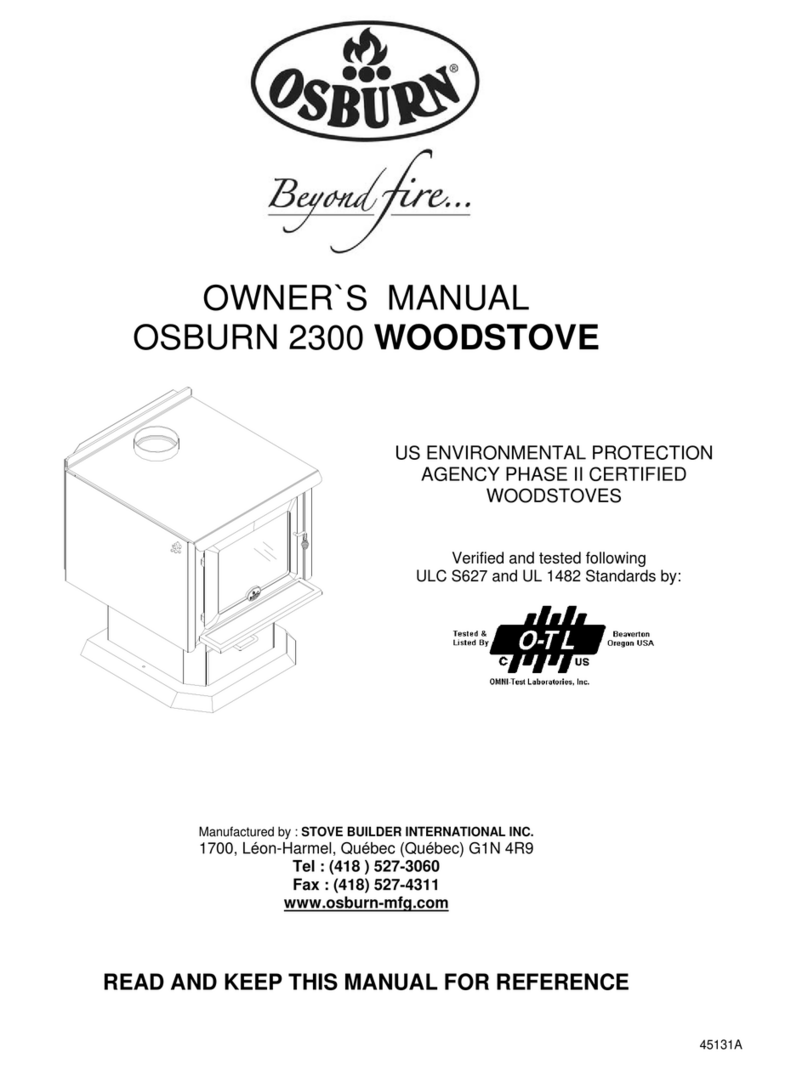
Osburn
Osburn 2300 User manual
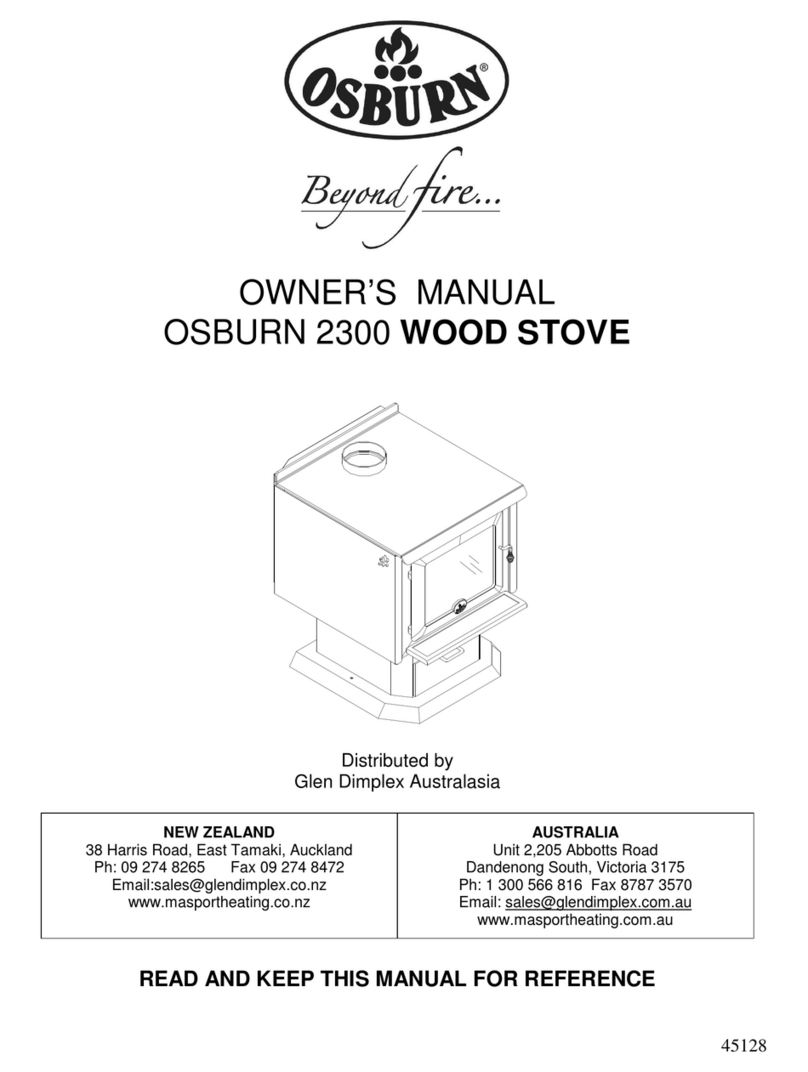
Osburn
Osburn 2300 User manual
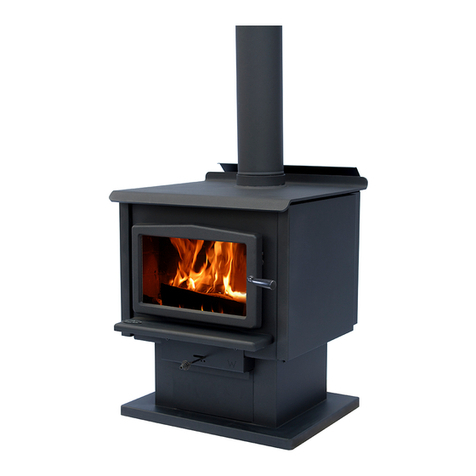
Osburn
Osburn 1600 User manual
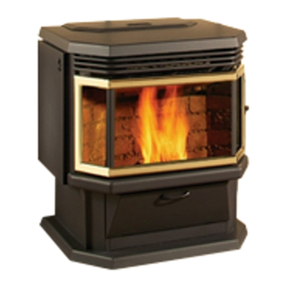
Osburn
Osburn HYBRID-45 MF User manual

Osburn
Osburn SOHO User manual
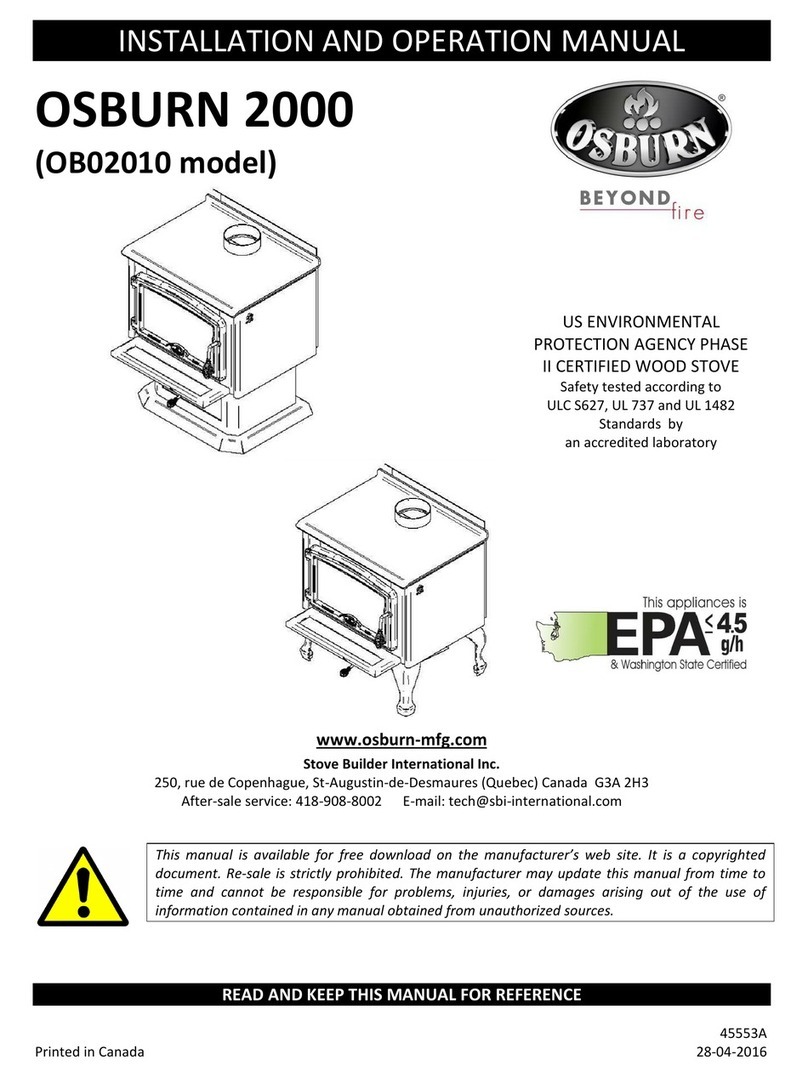
Osburn
Osburn 2000 User manual
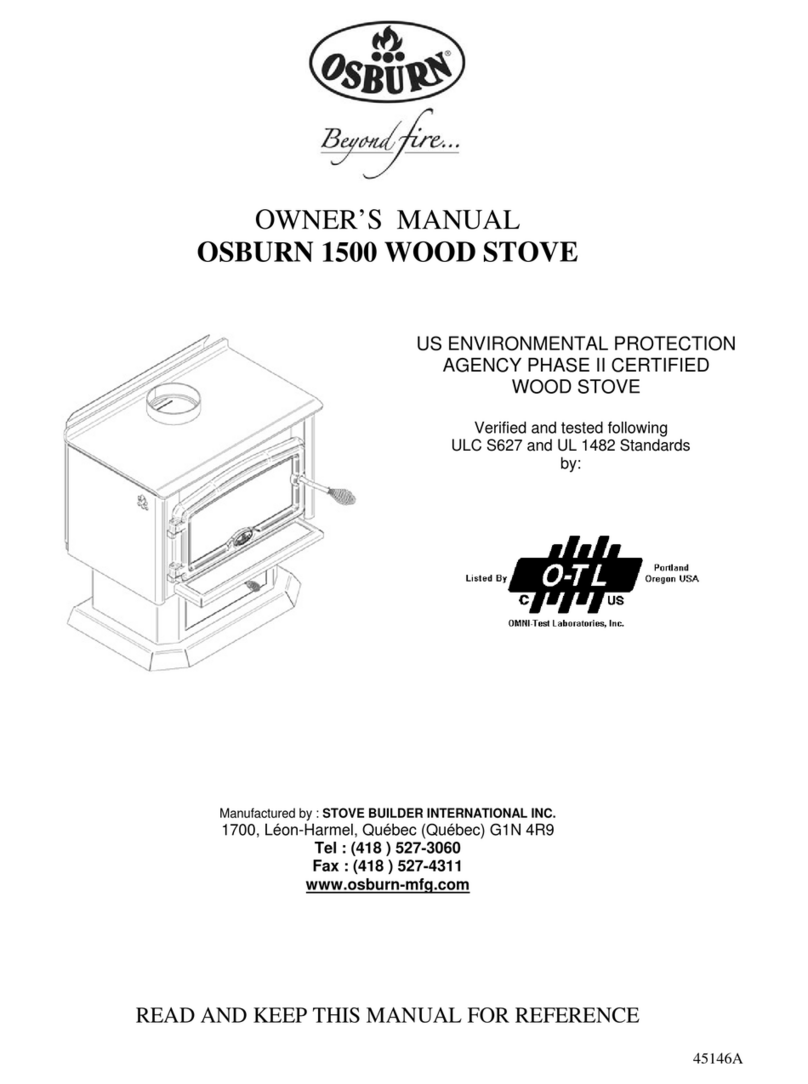
Osburn
Osburn 1500 User manual
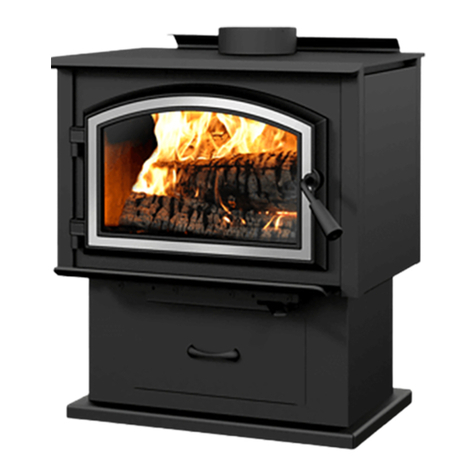
Osburn
Osburn Beyond Fire 1700 User manual
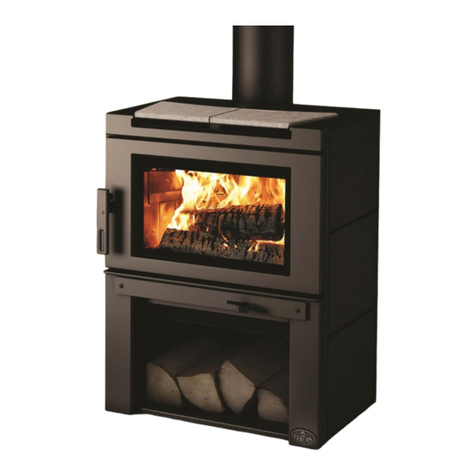
Osburn
Osburn MATRIX User manual
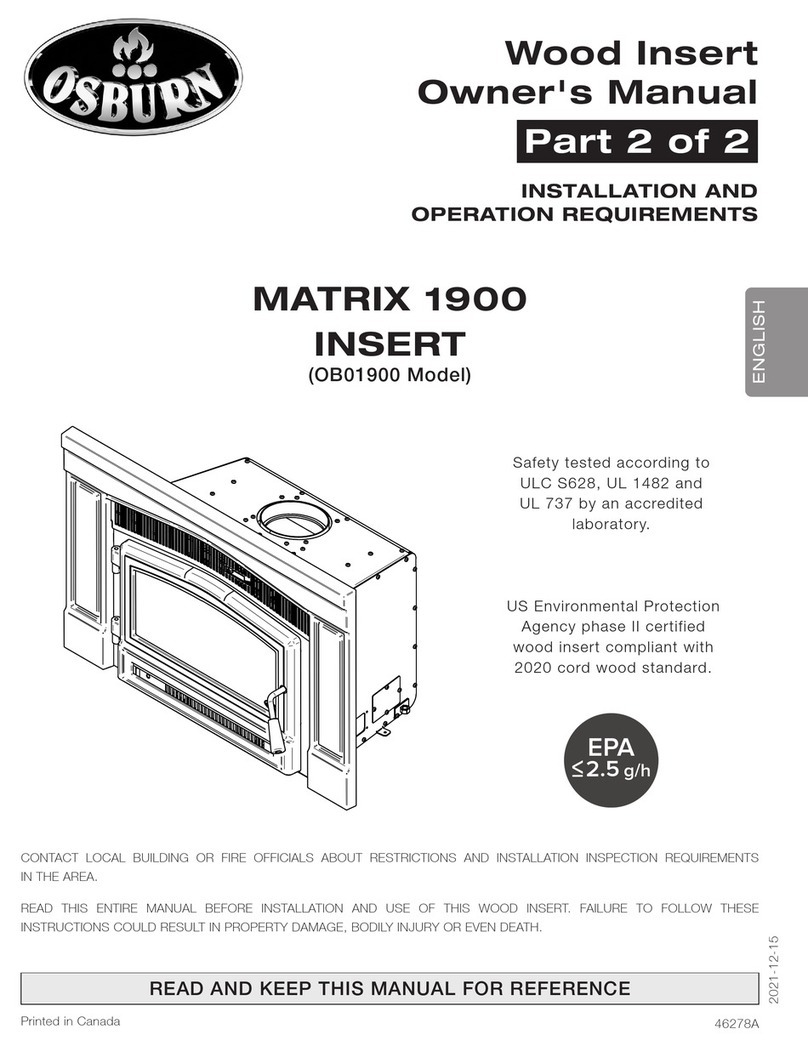
Osburn
Osburn MATRIX 1900 User manual
Popular Wood Stove manuals by other brands

RAIS
RAIS attika NEXO 100 GAS installation guide

WoodPro
WoodPro WS-TS-1500 owner's manual

Contura
Contura C 586W installation instructions

Palazzetti
Palazzetti EVA GENERAL INFORMATION - WARNINGS - INSTALLATION - MAINTENANCE

Lopi
Lopi 1250 Republic owner's manual

Panadero
Panadero CAPRI 3V Usage and maintenance instructions
